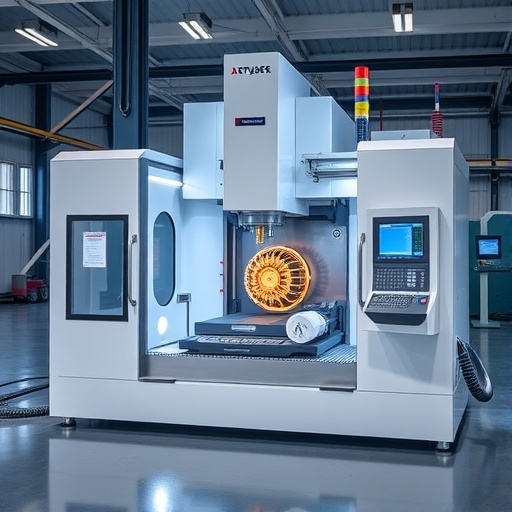In the ever-evolving landscape of manufacturing, five-axis machining stands out as a crucial technology for crafting intricate industrial components. This advanced machining method enables manufacturers to create precision parts by manipulating the cutting tool in multiple directions simultaneously. Recently, a significant breakthrough was made in the field of five-axis machining, which promises to revolutionize the manufacturing process for complex geometries, particularly utilizing non-spherical cutting tools. Researchers have unveiled a surface-partitioning and iso-scallop field-based strategy that enhances machining efficiency, reduces cycle times, and elevates surface quality.
At the heart of this innovative approach is the adaptive division of machining surfaces. Traditional methods often fall short when it comes to maximizing the efficiency of non-spherical cutting tools. By implementing a surface-partitioning technique, researchers can intelligently segment complex surfaces into manageable regions. This targeted division allows for optimized toolpath generation, making it possible to employ non-spherical cutting tools effectively. The result is a more agile manufacturing process that can respond better to the demands of producing intricate components across various industries.
Another distinguishing feature of this methodology is its iso-scallop field-based strategy. This aspect focuses on maintaining consistent scallop heights across the machining surface, which is critical for achieving high-quality finishes. By ensuring uniformity in scallop heights, the machining process minimizes the risk of surface blemishes and irregularities that could arise from variations in tool orientation and movement. This not only improves the aesthetic and functional qualities of the finished parts but also enhances their performance in actual applications.
One of the most immediate benefits of this new strategy is its ability to significantly shorten tool paths. Longer tool paths, which are often encountered in traditional machining processes, can lead to extended machining times and increased wear on the cutting tools. By reducing the length of these tool paths through adaptive partitioning, manufacturers can expect to see considerable gains in productivity. This reduction in machining time directly translates to cost savings, as fewer resources are consumed in the manufacturing process.
Moreover, the application of this cutting-edge strategy presents a substantial improvement in surface quality. Achieving a superior surface finish is paramount, especially in industries such as aerospace and automotive, where precision is non-negotiable. The enhanced control over tool orientation afforded by the iso-scallop field-based approach ensures that surfaces are machined to the highest standards, thus meeting stringent quality requirements. In this way, the new methodology not only pushes the envelope of what is technically possible but also aligns with the expectations of modern manufacturing.
In the context of smart manufacturing, this breakthrough lays the groundwork for incorporating intelligent optimization techniques into the machining process. As industries increasingly turn towards automation and data-driven methodologies, the potential for integrating advanced algorithms and machine learning into the manufacturing workflow grows. The surface-partitioning and iso-scallop field-based strategy could serve as a foundational element for future innovations that harness the power of technology to streamline production and optimize output.
Another aspect that cannot be overlooked is the environmental impact of more efficient machining processes. As manufacturers continuously strive to reduce waste and lower energy consumption, a reduction in machining time not only helps to conserve resources but also minimizes the overall carbon footprint of the manufacturing process. This aligns perfectly with global sustainability initiatives aimed at promoting a greener industrial landscape. More efficient processes contribute to fewer emissions and less waste, making this advancement beneficial from an environmental perspective as well.
On a practical level, the implications of this innovative approach extend across various sectors. Industries that rely on complex machined parts, such as aerospace engineering, automotive manufacturing, and medical device production, stand to benefit significantly. The ability to produce high-quality parts more efficiently can drive innovation forward in these sectors, enabling the creation of advanced technologies and solutions.
However, the transition to adopting this new strategy in industrial settings will require careful consideration. Manufacturers must evaluate their current machining practices and equipment to determine how best to integrate the surface-partitioning and iso-scallop field-based approach into their existing workflows. Training personnel and investing in compatible technologies will also be essential to fully leverage the potential of this groundbreaking strategy.
As the research progresses, ongoing developments and refinements of the methodology will likely lead to new insights and applications in five-axis machining. This field continues to be at the forefront of technological advancement, acting as a catalyst for innovation in manufacturing processes. The research community is poised to explore the nuances of this strategy further, making incremental improvements that can enhance efficiency, quality, and sustainability.
In conclusion, the introduction of a surface-partitioning and iso-scallop field-based strategy for non-spherical cutting tools heralds a new era in five-axis machining. This innovative method promises to transform the way complex industrial components are manufactured, paving the way for enhanced productivity, superior surface quality, and a sustainable manufacturing future. As the industry moves forward, the integration of this technology into mainstream practices will undoubtedly redefine the boundaries of precision machining, shaping the future of manufacturing.
Subject of Research: Five-axis machining strategies for non-spherical cutting tools
Article Title: Innovative Machining Approach Enhances Productivity and Quality
News Publication Date: October 2023
Web References: EurekAlert
References: [Recent studies on five-axis machining techniques]
Image Credits: EurekAlert
Keywords
Five-axis machining, surface-partitioning, iso-scallop field, non-spherical cutting tools, manufacturing efficiency, machining time, surface quality, intelligent optimization, smart manufacturing, environmental impact, industrial productivity, technological advancement.
Tags: advanced machining technologiesagile manufacturing processescomplex geometries in manufacturingcycle time reduction methodsfive-axis machininghigh-quality surface finishesintelligent manufacturing techniquesiso-scallop field-based approachmachining efficiency breakthroughsnon-spherical cutting toolsprecision parts manufacturingsurface-partitioning strategy





